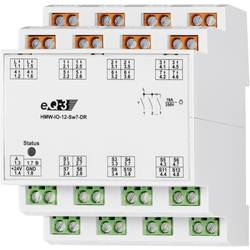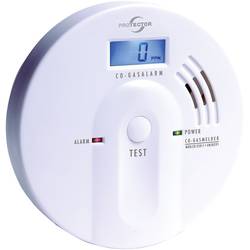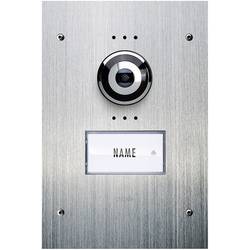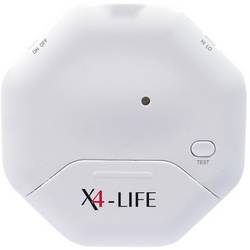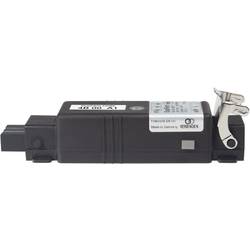€119.31
Priemerné hodnotenie:0/5(0x)
Vlastnosti a parametre výrobku
Skúsenosti užívateľov
Otázky a odpovede
Dokumentácia
Popis
Vlastnosti a parametre výrobku
| Séria (domáca technika) | Homematic |
|---|---|
| Cloudová integrácia (Smart Home) | Conrad Connect (CONRAD-CONNECT_SY_01) |
| Bezdrôtové zariadenie (Smart Home) | Hersteller-Spezifisch |
| spínací výkon (max.) | 3680 W |
| Napájanie | 230 V |
| Prevádzkové napätie | 24 V/DC |
| Kanálov | 19 |
| Spôsob montáže | Klobúčikové tienidlo |
| Vonkajšia šírka | 72 mm |
| Vonkajšia výška | 87 mm |
| Rozmer, hĺbka | 65 mm |
Skúsenosti a názory zákazníkov
- V montážnej skrini namontovaný Multi-I/O modul s 12 digitálnymi vstupmi a 7 relé výstupmi. Všetky výstupy sú vybavené funkciou timer. Výstupy sú galvanicky oddelené od vstupov. Konfiguračný software HomeMatic® centrály umožňuje jednoduchú konfiguráciu modulu.
Vlastnosti
- DIN montážna skriňa so šírkou 2 TE
- relé kontakt: 7x uzatvárač
Rozsah dodávky
- modul
- návod na použitie
Otázky užívateľov
- Dobrý den,
nikde se mi nepovedlo najít informaci, kolik je maximální množství spínacích modulů, resp. spínaných výstupů a vstupů, a zda vstupy umí rozlišit krátký a dlouhý stisk a dle toho provést 2 nebo více různých akcí.
Moc
Dokumentácia
Podmienky používania dokumentácie
Installations- und Bedienungsanleitung RS485 I/O-Modul 12 Eingänge 7 Schaltausgänge Hutschienenmontage HMW-IO-12-Sw7-DR Seite 4 – 20
Installation and Operating Manual RS485 I/O module 12 inputs 7 switch outputs for mounting on DIN rails HMW-IO-12-Sw7-DR Page 22 – 38
D
GB
2
1. Ausgabe Deutsch 10/2008
Dokumentation © 2007 eQ-3 Ltd., Hong Kong Alle Rechte vorbehalten. Ohne schriftliche Zustimmung des Herausgebers darf dieses Handbuch auch nicht auszugsweise in irgendeiner Form reproduziert werden oder unter Verwendung elektronischer, mechanischer oder chemischer Verfahren vervielfältigt oder verarbeitet werden.
Es ist möglich, dass das vorliegende Handbuch noch drucktechnische Mängel oder Druckfehler aufweist. Die Angaben in diesem Handbuch werden jedoch regelmäßig überprüft und Korrekturen in der nächsten Ausgabe vorgenommen. Für Fehler technischer oder drucktechnischer Art und ihre Folgen übernehmen wir keine Haftung.
Alle Warenzeichen und Schutzrechte werden anerkannt.
Printed in Hong Kong Änderungen im Sinne des technischen Fortschritts können ohne Vorankündigung vorgenommen werden.
76451 / V 1.01
3
1. English edition 10/2008
Documentation © 2007 eQ-3 Ltd., Hong Kong All rights reserved. No parts of this manual may be reproduced or processed in any form using electronic, mechanical or chemical processes in part or in full without the prior explicit written permission of the publisher.
It is quite possible that this manual has printing errors or defects. The details provided in this manual are checked regularly and corrections are done in the next edition. We do not assume any liability for technical or printing errors.
All registered trade marks and copyrights are acknowledged.
Printed in Hong Kong.
We reserve the right to make changes due to technical advancements without prior notice.
76451 / V 1.01
4
Inhaltsverzeichnis 1 Hinweise zu dieser Anleitung …5
2 Gefahrenhinweise …5
3 Funktion …7
4 Allgemeine Systeminformation zu HomeMatic 8
5 Allgemeine Hinweise zum Bussystem…9
5.1 Allgemeine Hinweise zur Installation…9
5.2 Topologie des Bussystems …11
6 Installation …12
7 Zuordnung der Tastereingänge…16
7.1
Anlernen von Tastereingängen an Aktorkanäle 177.2 Aufheben der Zuordnung von Tastereingängen zu Aktorkanälen . . . . . . . . . 18
8 Wartung und Reinigung…19
9 Technische Daten…20
5
1 Hinweise zu dieser Anleitung Lesen Sie diese Anleitung sorgfältig, bevor Sie ihre HomeMatic Komponenten in Betrieb nehmen.
Bewahren Sie die Anleitung zum späteren Nachschlagen auf!
Wenn Sie das Gerät anderen Personen zur Nutzung überlassen, übergeben Sie auch diese Bedienungsanleitung.
Benutzte Symbole: Achtung! Hier wird auf eine Gefahr hingewiesen.
Hinweis. Dieser Abschnitt enthält zusätzliche wichtige Informationen!
2 Gefahrenhinweise Die beschriebenen Aktoren sind Teil einer Gebäudeinstallation. Bei der Planung und Errichtung von Elektrischen Anlagen sind die einschlägigen Normen und Richtlinien des Landes zu beachten, in dem die Anlage installiert wird.
Der Betrieb des Gerätes ist ausschließlich am
6
230V /50 Hz-Wechselspannungsnetz zulässig.
Arbeiten am 230 V-Netz dürfen nur von einer ElektroFachkraft (nach VDE 0100) erfolgen. Dabei sind die geltenden Unfallverhütungsvorschriften zu beachten.
Zur Vermeidung eines elektrischen Schlages vor Arbeiten am Gerät Netzspannung freischalten (Sicherungs automat abschalten).
Bei Nichtbeachtung der Installationshinweise können Brand oder andere Gefahren entstehen.
Betreiben Sie das Gerät nur in Innenräumen und vermeiden Sie den Einfluss von Feuchtigkeit, Staub sowie Sonnen- oder andere Wärmebestrahlung.
Belasten Sie die Geräte nur bis zur angegebenen Leistungs grenze. Eine Überlastung kann zur Zerstörung des Gerätes, zu einem Brand oder elektrischen Unfall führen.
Die Geräte sind nicht zum Freischalten geeignet. Öffnen Sie das Gerät nicht, es enthält keine durch den Anwender zu wartenden Teile.
Das Öffnen des Gerätes birgt die Gefahr eines Stromschlages.
Beachten Sie beim Anschluss an die Geräteklemmen die hierfür zulässigen Leitungen und Leitungsquerschnitte.
7
Beachten Sie die Installationsvorschriften für Installationen in Verteilersystemen.
3 Funktion – 12Tastereingänge.
– TasteranschlüssefreiKonfigurierbarund beliebigen Aktorkanälen (auch von anderen Modulen) zuweisbar.
– 7Relaisausgänge.
– 3680VA(230V/16A)Gesamt-Schaltleistungaller Relaisausgänge zusammen.
– GeringerVerdrahtungsaufwanddurchgemein-same Spannungsquelle.
– GalvanischeTrennungvonEingängenundAusgängen.
– UmfangreicheKonfigurationsmöglichkeitenüber die HomeMatic Zentrale.
– NichtflüchtigerSpeicherfürKonfigurationsdaten.- MontageaufeinerStandard-Hutschieneinnerhalb von Vertei lungen.
– GalvanischgetrennterLeistungs-undBusteil.
8
(A) – Außenleiteranschluss Lastseite (B) – Ausgangsklemmen Kanäle 1 – 7
(C) – Bus A
(D) – Bus B
(E) – Busspannungsversorgung (F) – Klemmen Tastereingänge 4 Allgemeine Systeminformation zu HomeMatic Dieses Gerät ist Teil des HomeMatic Haussteuersystems.
AlleGerätewerdenmiteinerStandardkonfiguration ausgeliefert. Darüber hinaus ist die Funktion des
9
Gerätes über ein Programmiergerät und Software konfigurierbar.WelcherweitergehendeFunktionsumfang sich damit ergibt, und welche Zusatzfunktionen sich im HomeMatic System im Zusammenspiel mit weiteren Komponenten ergeben, entnehmen Sie bittedergesondertenKonfigurationsanleitungoder dem HomeMatic Systemhandbuch.
AlletechnischenDokumenteundUpdatesfindenSie stets aktuell unter www.HomeMatic.com.
5 Allgemeine Hinweise zum Bussystem 5.1 Allgemeine Hinweise zur Installation Grundsätzlich kann man die Anschlüsse der HMWKomponenten in zwei Gruppen einteilen. In die Lastseite und in die Steuerseite (24 V- Spannungsversorgung, Tastereingänge, RS485-Bus).
Lastseite Da lastseitig typischerweise 230 V-Netzverbraucher geschaltet werden, ist hier der Einsatz von VDEgerechten Installationsleitungen, wie beispielsweise NYM-Leitung etc., erforderlich. Die Leitungsquer-
10
schnitte richten sich nach den gängigen VDEVorschriften und betragen für Installationen im Nennlastbereich der Aktoren 1,5 mm2.
Steuerseite Auf der Steuerseite hingegen kommt lediglich ungefährliche Schutzkleinspannung zum Einsatz.
Da innerhalb der Module eine galvanische Trennung zwischen Last und Steuerseite besteht, brauchen hier keine netzspannungsfesten Leitungen verwendetzuwerden.EsempfiehltsichdieVerwendung von Fernmelde-Installationsleitung oder vergleichbarer Steuerleitung. Zu beachten ist allerdings, dass die Leitungen von Last und Steuerseite innerhalb der Unterverteilung getrennt entsprechend den VDERichtlinien zu verlegen sind. Dabei ist ein Mindestabstand von 8 mm zwischen beiden Leitungsarten zu beachten.
Beim Anschluss des RS485-Busses sind die A-Klemmen (1.3), die B-Klemmen (1.7), die 24 VSpannungs versorgung und die Masseklemmen (1.8) der Module einer Unterverteilung (max. 127 Stück) jeweils miteinander zu verbinden. Ein AnschlussschemamitBus-SystemfindenSieimSystemhandbuch. Beim Einsatz mehrerer Module ist ein Busab-
11
schluss erforderlich. Informationen zum Anschluss findenSieinderjeweiligenBedienungsanleitung.
5.2 Topologie des Bussystems Aus Gründen der Übersicht sollten die HMW-Komponenten immer gruppenweise in Unterverteilungen montiert werden. Wie viele Unterverteilungen angemessen sind, hängt dabei von der Art und Größe des zu realisierenden Projektes ab und ist individuell festzulegen.
Es ist auf jeden Fall zu empfehlen, auf jeder Etage mindestens eine Unterverteilung zu installieren. Bei größeren Gebäuden kann es auch sinnvoll sein, mehrere Verteilungen pro Etage (z. B. separat für jeden Flur) vorzusehen. Entsprechend sind alle Lastund Steuerleitungen sternförmig zu den entsprechenden Unterverteilungen zu führen. Die Stromversorgung erfolgt über das Hutschienen-Netzteil HMW-Sys-PS7-DR oder ein anderes, entsprechend der Anzahl und Gesamtstromaufnahme aller vorhandenen Module in der jeweiligen Unterverteilung dimensioniertes 24 V-Netzteil. Wenn eine zentrale Programmierung und Steuerung über die HomeMatic Zentrale erfolgen soll, sollten die HMW-Bus-
12
leitungen der einzelnen Unterverteilungen sowie die vom Steuer-PC bzw. einer Zentrale kommende Leitung an einem unter räumlichen Gesichtspunkten günstigen Ort zusammengeführt werden, um eine Trennung der einzelnen Busabschnitte zu erreichen und ggf. eine Fehlersuche zu vereinfachen. Üblicherweise ist dies der Raum, in dem die Zentrale des HomeMatic-Systems installiert wird.
6 Installation Beachten Sie die Installationsvorschriften für Installationen in Verteilersystemen.
Setzen Sie das Hutschienengerät auf die Hutschiene auf und verriegeln Sie es. Achten Sie dabei darauf, dass die Rastfeder komplett einrastet und das Gerät fest auf der Schiene sitzt.
Isolieren Sie die Drahtenden der Netzzuleitung, der Leitung zur Last, den Leitungen zu den Tastern, zum Netzteil und der Busleitung auf eine Länge von 8
mm ab, ohne dabei die blanke Ader zu verletzen.
Beachten Sie die zugelassenen Leitungsquerschnitte!
13
Verdrahten Sie den Netzanschluss und Lastanschluss mit der 230 V-Netzspannung gemäß den nachfolgenden Anschlussbildern.Vergewissern Sie sich, dass alle Anschlüsse fest und sicher in den Installationsklemmen fixiertsind.
Verdrahten Sie die Hutschienenmodule zur Busspannungsversorgung (Klemmen 1.4 und 1.8) mit dem Netzteil. Achten Sie dabei strikt auf den polaritätsrichtigen Anschluss an den Klemmen.
Beachten Sie bei der Beschaltung der Tastereingänge, dass auch tatsächlich Taster (Schließer) und keine Kipp- oder Rastschalter verwendet werden. Schließen Sie die Taster jeweils zwischen GND (Klemme 1.8) und dem jeweiligen Tastereingang (Klemme S1, …) an.
Die maximale Leitungslänge vom Taster zum Modul ist je nach verwendeter Leitung unterschiedlich. Es sollte jedoch eine Länge von 50
m nicht überschritten werden.
14
15
KlemmeFunktion 1.1, 1.5Außenleiteranschluss 2.1, 2.5Geschaltete Phase Kanal 1
3.1, 3.5Geschaltete Phase Kanal 2
4.1, 4.5Geschaltete Phase Kanal 3
1.2, 1.6Geschaltete Phase Kanal 4
2.2, 2.6Geschaltete Phase Kanal 5
3.2, 3.6Geschaltete Phase Kanal 6
4.2, 4.6Geschaltete Phase Kanal 7
1.3RS485-Bus (Bus A) 1.7RS485-Bus (Bus B) 1.4Spannungsversorgung 24 V / DC
1.8Spannungsversorgung Masseanschluss 2.3Tastereingang S1
2.7Tastereingang S2
3.3Tastereingang S3
3.7Tastereingang S4
4.3Tastereingang S5
4.7Tastereingang S6
2.4Tastereingang S7
2.8 Tastereingang S8
3.4Tastereingang S9
3.8Tastereingang S10
4.4Tastereingang S11
4.8Tastereingang S12
16
Zugelassene Leitungsquerschnitte.
starre Leitung [mm2]flexible Leitung mit Aderendhülse [mm2] 0,14 – 2,500,14 – 1,5
7 Zuordnung der Tastereingänge Die 12 Tastereingänge des HMW-IO-12-Sw7-DR
lassen sich ohne die HomeMatic Zentrale zu Aktorkanälen anderer(!) Aktoren, die Kanaltasten am Gerät besitzen zuordnen.
Da dieses Gerät keine Programmiertaster für die Ausgangskanäle besitzt, können die Ausgangskanäle nur über die HomeMatic Zentrale zugeordnet werden. Im Auslieferungszustand ist das Gerät komplett unprogrammiert.
7.1 Anlernen von Tastereingängen an Aktorkanäle Bitte lesen Sie diesen Abschnitt erst vollständig,bevorsiemitdemKonfigurieren beginnen!
17
Im Auslieferungszustand sind die Tastereingänge keinem Aktorkanal zugeordnet (auch nicht den Aktorkanälen des Gerätes an dem sie sich befinden).
Zuordnung von Tastereingängen zu Aktorkanälen- DrückenSiedieProgrammiertastedeszuzu-ordnenden Aktor(kanals) am Modul so lange, bis dessen Kanal-LED langsam blinkt (nach ca.
3Sekunden).DasModulbefindetsichnunim Anlernmodus.
– BetätigenSienuneinenTasterandemTas-tereingang (am selben oder einem beliebigen anderen am Bus angeschlossenen Moduls) dem Sie den Aktor(kanal) zuordnen wollen.
– DerAktor(kanal)istnundiesemSchalteingangzugeordnet, und die Kanal-LED am Aktor erlischt.
– TestensiedieZuordnungdurchDrückendeszugeordneten Tasters. Der Aktor(kanal) sollte entsprechendderKonfigurationdesTastereingangs reagieren.
– WollenSiedenAktor(kanal)einemweiterenTastereingang zuordnen, so wiederholen sie diesen Vorgang.
18
Je nach Aktor werden Tastereingänge unterschiedlich angelernt: AktorTastenverhalten Schaltaktor, DimmaktorAngelernte Tasten verhalten sich wie Toggle-Taster JalousieaktorJe nachdem ob der Anlernmodus am Aktor mit der ▲- oder ▼- Taste ausgelöst wurde wird die anzulernende Taste als „Öffnen“ oder „Schließen“ angelern, nicht als Toggle-Taste.
Wird eine an einen Aktor angelernte Taste erneut an denselben Aktor angelernt, wird die alte Zuordnung überschrieben.
7.2 Aufheben der Zuordnung von Tastereingängen zu Aktorkanälen Aufheben der Zuordnung von Tastereingang und Aktor(kanal) – DrückenSiedieProgrammiertastedesAktor(kanals), dessen Zuordnung Sie aufheben möchten so lange, bis dessen Kanal-LED vom
19
langsamen in das schnelle Blinken übergeht (nach ca. 6 Sekunden).
– LassenSiedieTastelos.DasSchaltmodulbefindetsichnunimLöschmodus.
– DrückensienuneinenTasteramTastereingangeines Moduls, dessen Zuordnung Sie aufheben wollen. Die Kanal-LED am Aktor erlischt und die Zuordnung ist aufgehoben, der Aktor(kanal) wird von diesem Schalteingang nicht mehr geschaltet.
– ÜberprüfenSiedieEinstellungdurchBetätigeneines Tasters am gelöschten Tastereingang, der Aktor(kanal) darf nicht mehr reagieren.
Alle Anlernvorgänge können Sie durch kurzes Betätigen der Programmiertaste abbrechen.
8 Wartung und Reinigung Das Produkt ist wartungsfrei. Überlassen Sie eine Reparatur einer Fachkraft.
20
9 Technische Daten Kommunikation: RS485-Bus Gehäuseabmessungen: Standard-Hutschienengehäuse mit 4 TE Breite 87 x 72 x 65 mm (H x B x T) Ausgänge: 7 unabhängige potentialfreie Relaisschaltausgänge Schaltvermögen: 230 V / 50 Hz / max. 16 A (pro Relais), Summe aller Kanäle max. 16A
Spannungsversorgung: 24 V / DC
Stromaufnahme: 150 mA (max.) Steuereingänge: 12 unabhängige Tastereingänge (Schutzkleinspannung)
21
Entsorgungshinweis:Gerät nicht im Hausmüll entsorgen! Elektronische Geräte sind entsprechend der Richtlinie über Elektro- und Elektronik-Altgeräte über die örtlichen Sammelstellen für Elektronik-Altgeräte zu entsorgen.
Das CE-Zeichen ist ein Freiverkehrszeichen, das sich ausschließlich an die Behörden wendet und keine Zusicherung von Eigenschaften beinhaltet.
22
Table of Contents 1 Information concerning these instructions..23
2 Hazard information …23
3 Function …25
4 General system information on HomeMatic .26
5 General information on the bus system . . . . 27
5.1 General information on the installation…27
5.2 Topology of the bus system …29
6 Installation …30
7 Allocation of button inputs …34
7.1
Teaching button inputs to actuator channels..347.2 Clearing assignments of button inputs to actuator channels…36
8 Maintenance and cleaning …37
9Technicalspecifications …38
23
1 Information concerning these instructions Read these instructions carefully before beginning operation with your HomeMatic components.
Keep the instructions handy for later consultation!
Please hand-over the operating manual as well when you hand-over the device to other persons for use.
Symbols used: Attention! This indicates a hazard.
Note. This section contains additional important information!
2 Hazard information The described actuators are part of a building installation. When planning and setting up electrical systems, the pertinent standards and regulations of the respective country of installation are to be observed.
24
Operating the device is only permitted with a 230V/50 Hz alternating current network.
Work on the 230 V network is only permitted by qualifiedelectricians(inaccordancewithVDE0100).
Always observe the applicable accident prevention regulations.
Disconnect the power to devices before working on them to prevent electrocution (switch circuit breaker).
Ignoringinstallationinstructionscancausefiresor other hazards.
This device is to be operated indoors only and keep away from the influences of humidity, dust and sunshine or other radiating heat sources.
Loadthedevicestothespecifiedlimitsonly.An overloadcancausedestroythedevice,causefires or electrical accidents.
The devices are not intended to be isolated. Do not open the device. It does not contain any parts to be maintained by the user. There is a risk of electrical shock by opening the device.
25
Makesurethatthespecifiedwiringandwire cross-sections are used when connecting to device terminals.Observe the installation instructions for installations in distribution systems.
3 Function – 12buttoninputs.
– Buttonconnectionscanbeconfiguredas desired and optional actuator channels can be assigned (from other modules as well).
– 7relayoutputs.
– 3680VA(230V/16A)Totalswitchingcapacityof all relay outputs together.
– Lowwiringrequirementsbecauseofcommonpower source.
– Electricalisolationofinputsandoutputs.
– Extensiveconfigurationcapabilitiesthroughthe HomeMatic Centers.
– Non-volatilememoryforconfigurationdata.- InstallationonastandardDINrailwithindivisi-ons.
– Electricallyisolatedpowerandbussegments.
26
(A) – External conductor connection Load side (B) – Output terminal Channels 1 – 7
(C) – Bus A
(D) – Bus B
(E) – Bus power supply (F) – Button input terminals 4 General system information on HomeMatic This device is a component of the HomeMatic Home Control System.
Alldevicesaredeliveredinastandardconfiguration.
Thefunctionalityofthedevicecanalsobeconfi-
27
gured with a programming device and software.
Further resulting functionality and the additional functions provided in the HomeMatic system combined with other components are described in theseparateConfigurationInstructionsandinthe HomeMatic System Manual. All current technical documents and updates are provided under www.
HomeMatic.com.
5 General information on bus system 5.1 General information on the installation Basically, the connections of the HMW components can be divided into two groups. In the load side and in the control side (24 V power supply, button inputs, RS485 Bus).
Load side Since normally a 230 V consumer is on the load side, using VDE-conforming installation wires, such as e.g. NYM wiring, etc. is required. The wire crosssection conform with the standard VDE regulations and is 1.5 mm2 for installations in the nominal load
28
range of actuators.
Control side On the control side however, only non-hazardous safety extra-low voltages are used. Since there is electrical isolation between the load and control sides in the module, no mains power capable wires have to be used. Using interior telecommunications wiring or comparable control wiring is recommended. Make sure however, that the wires of the load and the control side are separated conforming with VDE regulations within the sub-distribution. Keep a minimum spacing of 8 mm between the two types of wiring.
When connecting the RS485 bus, the A terminals (1.3), the B terminals (1.7), the 24 V power supply and the ground terminal (1.8) of the modules of a sub-distribution (max. 127 segments) are to be connected with one another. A connection diagram with bus system is provided in the system manual.
When using several modules, a bus termination is required. Information on the connections is provided in the respective operating instructions.
29
5.2 Topology of the bus system The HMW components should always be mounted in groups of sub-divisions to provide a better overview. The number of sub-divisions that is appropriate depends on the type and size of the project and istobedefinedaccordingly.
Installing at least one sub-division on each level is recommended. Larger buildings may require planning several sub-divisions per level (e.g. separate for every floor). All load and control wiring should also be run in a star format to the respective subdivisions. The power supply is done through a DIN
rail power supply HMW-Sys-PS7-DR or another 24 V power supply dimensioned according to the number and total current consumption of all existing modules in the respective sub-division. If central programming and control is to be done through the HomeMatic Centre, the HMW bus lines for the individual sub-divisions and the lines coming from the control PC or a Centre should be run together in a room according to available space in order to achieve a separation of the individual bus segments and to simplify troubleshooting if necessary. Normally, this is the room in which the HomeMatic system Centre is installed.
30
6 Installation Observe the installation instructions for installations in distribution systems.
Position the DIN rail device on the DIN rail and lock it in place. Make sure that the spring latch is completely latched and that the device is seated solidly on the rail.
Insulate the wire ends of the power line, the line to load, the lines to the buttons, to the power supply and the bus line to a length of 8 mm, without damagingthewireitself.Observethespecifiedwire cross-sections!
Wire the power supply connection and the load connection with the 230 V power supply according to the following connection diagrams.
Ensure that all connections are fastened securely to the installation terminals.
Wire the DIN rail modules for the bus power supply (terminals 1.4 and 1.8) with the power supply. Make
31
sure that the connections are made with correct polarity on the terminals.Note that actual buttons (normally open) and no rocker switches or push-button switches are used in the button input circuits. Connect each of the buttons between GND (terminal 1.8) and the respective button input (terminal S1, …).
The maximum wire length from button to module is different depending on the wire used. A length of 50 m should never be exceeded however.
32
33
TerminalFunction 1.1, 1.5External conductor connection 2.1, 2.5Switched channel 1
3.1, 3.5Switched channel 2
4.1, 4.5Switched channel 3
1.2, 1.6Switched channel 4
2.2, 2.6Switched channel 5
3.2, 3.6Switched channel 6
4.2, 4.6Switched channel 7
1.3RS485-Bus (Bus A) 1.7RS485-Bus (Bus B) 1.4Power supply 24 V / DC
1.8Power supply Ground connection 2.3Button input S1
2.7Button input S2
3.3Button input S3
3.7Button input S4
4.3Button input S5
4.7Button input S6
2.4Button input S7
2.8 Button input S8
3.4Button input S9
3.8Button input S10
4.4Button input S11
4.8Button input S12
34
Permitted wire cross-sections.
Rigid wire [mm2]Flexible wire with end sleeve [mm2] 0.14 – 2.500.14 – 1.5
7 Allocation of button inputs The 12 button inputs of the HMW-IO-12-Sw7-DR
can be assigned to actuator channels of other(!) actuators that have channel buttons on the device without the HomeMatic center.
Since this device has no programming button for the output channels, the output channels can only be assigned via the HomeMatic Center.
The device is completely unprogrammed in delivery status.
7.1 Teaching button inputs to actuator channels Please read this section completely before startingwithanyconfiguring!
35
The button inputs are not assigned to any actuator channels in factory status (not the actuator channels of the device on which they are located either).
Assignment of button inputs to actuator channels- Presstheprogrammingbuttonoftheactuator(channel) to be assigned on the module until the channel LED flashes slowly (after approx. 3
seconds). The module is now in teach mode.
– Now,actuateabuttononthebuttoninput(onthe same module or any other module on the bus) that you want to assign to the actuator (channel).
– Theactuator(channel)isnowassignedwiththis switch input and the channel LED goes dark on the actuator.
– Testtheassignmentbypressingtherespectivebutton. The actuator (channel) should react accordingtotheconfigurationofthebutton input.
– Ifyouwanttoassignanotherbuttoninputtothe actuator (channel), repeat this procedure.
36
Depending on the actuator, button inputs are taught differently: ActuatorButton behavior Switch actuator, Dimming actuatorTaught buttons behave like toggle switches Blind actuatorDepending on whether teach mode on the actuator was triggered with the ▲- or ▼- button, the button to be taught is taught as "Open" or "Close", not as a toggle button.
If a button that was taught for an actuator is taught for the same actuator again, the old assignment is overwritten.
7.2 Clearing the assignment of button inputs to actuator channels Clearing the assignment of a button input and actuator (channel) – Presstheprogrammingbuttonoftheactuator(channel) that you want to clear the assignment for until the respective channel LED switches
37
from slow flashing to quickly flashing (after approx. 6 seconds).
– Releasethebutton.Themoduleisnowindelete mode.
– Now,pressabuttononthebuttoninputofa module for which you want to clear the assignment. The channel LED on the actuator goes dark and the assignment is deleted, the actuator (channel) is no longer actuated on this switch input.
– Testthesettingbyactuatingabuttononthedeleted button input, the actuator (channel) should not react.
All teach procedures can be aborted by briefly actuating the programming button.
8 Maintenance and cleaning This product is maintenance-free. Repairs are only to be done by trained professionals.
38
9 Technical specifications Communication: RS485-Bus Housing dimensions: Standard DIN rail housing with 4 units width 87 x 72 x 65 mm (H x W x D) Outputs: 7 independent potential-free relay switching outputs Switching capacity: 230 V / 50 Hz / max. 16 A (per relay), buzzer all channels max. 16A
Voltage supply: 24 V / DC
Current consumption: 150 mA (max.) Control inputs: 12 independent button inputs (safety extra-low voltage)
39
Instructions for disposal:Do not dispose off the device as part of household garbage! Electronic devices are to be disposed of in accordance with the guidelines concerning electrical and electronic devices via the local collecting point for old electronic devices.
The CE sign is a free trade sign addressed exclusively to the authorities and does not include any warranty of any properties.
eQ-3 AG
Maiburger Straße 29
D-26789 Leer www.eQ-3.com

